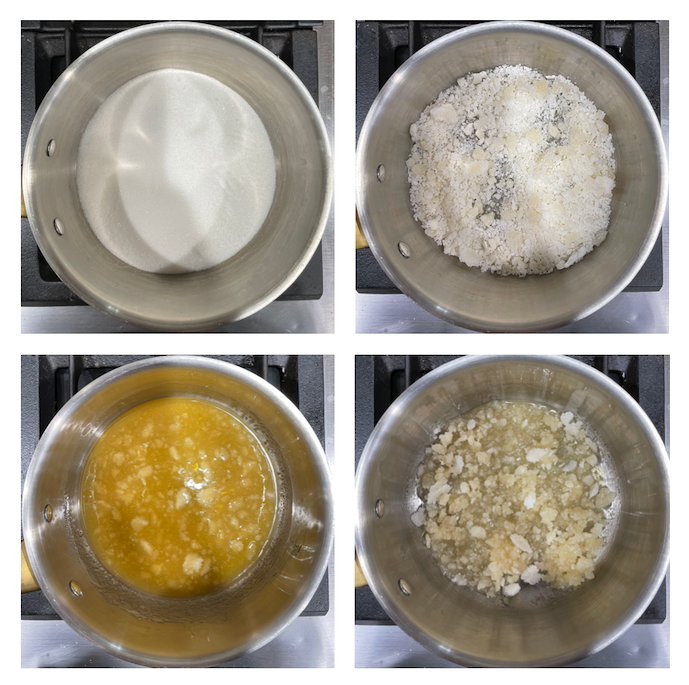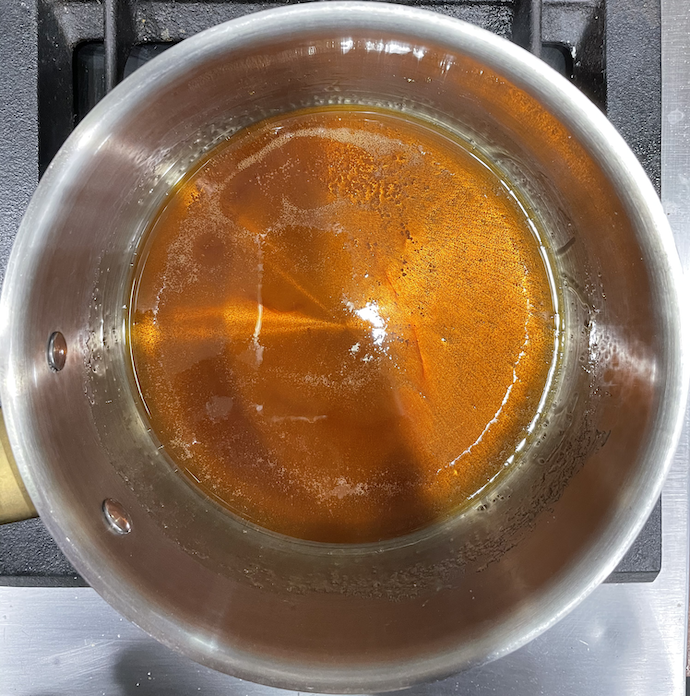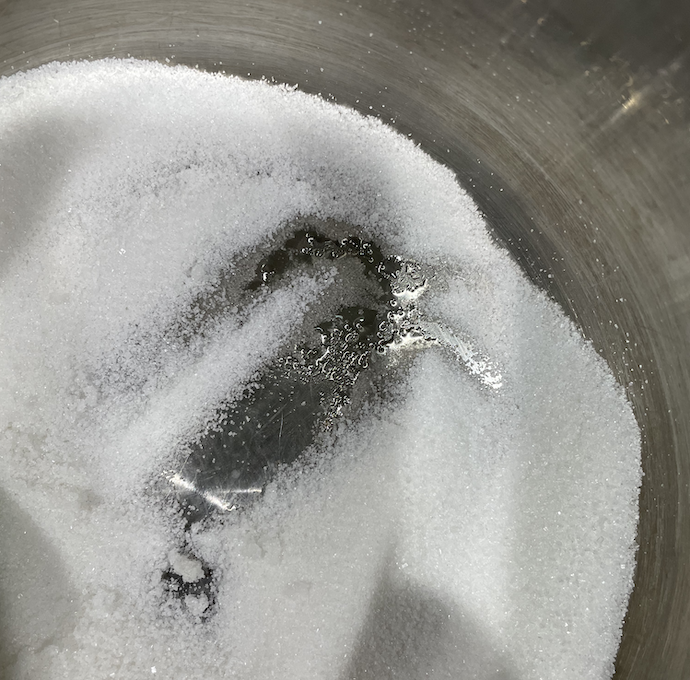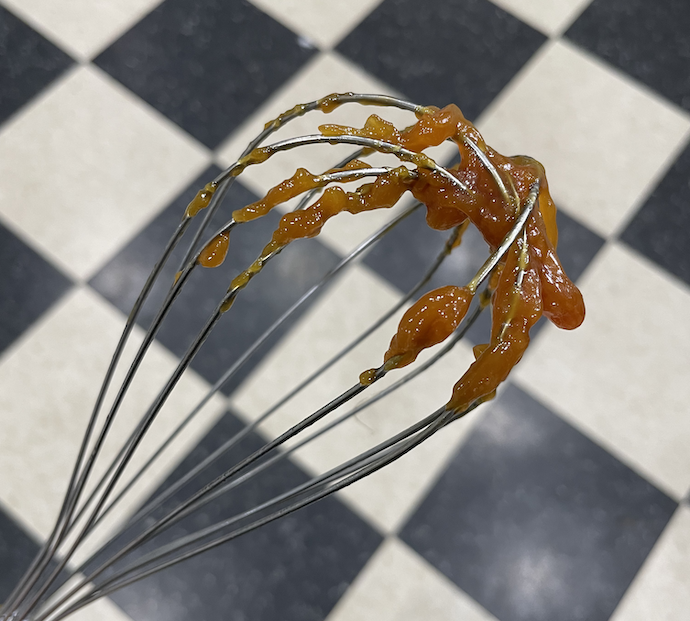
Many people (myself included) enjoy watching the cooking competition show The Great British Bake Off: Not only is it entertaining but the recipes look delicious. One thing I noticed when watching the show is that, when instructed to bake something with caramel, contestants usually grumble. The reason is that cooking caramel is a precarious task — One wrong move and the entire batch is ruined. Let’s examine the complex physical phenomena at play when making this sweet delicacy.
The Basics of Cooking Caramel
Did you know that Milton S. Hershey, the famous creator of the Hershey’s® chocolate bar, started his career in confection by making caramel, not chocolate? Or that the popular flavor of salted caramel was invented as recently as the 1970s, by a chocolatier named Henry Le Roux? Aside from these fun facts, there is a lot we don’t know about the caramelization process, from cooking it to understanding the complexities of the chemical process itself.
Technically, the only ingredient you actually need to make caramel is sugar (although many recipes for caramel sauce also call for water, butter, cream, and a bit of salt to cut down the sweetness). The process itself seems simple. According to Fine Cooking, caramel can be made using either a dry or wet method:
- Dry: White granulated sugar is placed over a medium-high heat and cooked until it turns liquid and becomes golden brown
- Wet: Water is added to the pan, which allows the sugar to cook longer and develop better flavors

Different stages of the caramel cooking process when using the “dry” method (clockwise from start to almost finished).

Caramelized granulated sugar (sucrose).
Seems easy, right? Not so fast. Different factors, if ignored, will ensure that your caramel ends up in the trash can instead of on a delicious crème brûlée or chocolate torte.
Burning
While cooking sugar to make caramel, it is important to keep a close eye on the heat so that the caramel doesn’t end up burnt. Tip: Using a candy thermometer is a good way to keep track of the precise temperature of the caramel and how it will change.
| Temperature | Caramel Status |
|---|---|
| 160°C (320°F) | Granulated sugar turns to clear, molten liquid sugar |
| 171°C (340°F) | The liquid sugar starts to turn into a pale brown; brittle when cooled |
| 179°C (355°F) | The caramel starts to turn medium brown; hard when cooled |
| 185°C (365°F) | The caramel turns dark brown; soft and sticky when cooled |
| 210°C (410°F) | The caramel turns black and bitter; often used in this stage as a coloring agent |
Another important aspect of temperature to consider: When the caramel starts to brown, that means that 80% of the water in the substance has evaporated. Water requires so much energy to boil that the temperature will be constant at the water’s boiling point, and when most of the water has evaporated, all of that energy is used to increase the temperature of the caramel. The temperature of the caramel can rise so rapidly that it is hard to keep it in the desired temperature range, shown above. As a result, the caramel could burn and taste bitter.
Recrystallization
If you choose to cook your caramel using the wet method, by adding water to the sugar, it introduces a risk: Sugar syrup can splash up on the sides of the pan. The water evaporates, leaving sugar crystals behind. If even one sugar crystal falls back into the pan of cooking caramel, it starts a chain reaction of sugar crystals and the entire pan will harden. The result? Gross, grainy caramel that is unusable in most recipes.

When making caramel, you need to closely monitor the sides of the pan for sugar crystals.
Many chefs, including the aforementioned The Great British Bake Off contestants, have a special remedy to avoid recrystallization: They constantly brush down the sides of the pan with a wet pastry brush to make sure no sugar crystals form from the evaporating sugar syrup. However, using one hand to brush down the sides of the pan and the other hand to hold a candy thermometer means the caramel cooking process is no cake walk (see what I did there?)
Exploring the Chemistry Behind the Caramelization Process
When making caramel at your stovetop, you might assume that the granulated sugar crystals are melting into a sauce — they’re not. Instead, the sugar is undergoing a complex chemical reaction in which the chemical compounds break down by heat, without the use of a protein or enzyme to speed up the process.
In terms of basic sucrose (table sugar), the caramelization process involves four major steps. First, sucrose inversion takes place, in which the disaccharide sucrose is broken down into two monosaccharides: glucose and fructose.
Then, condensation occurs from the applied heat. The sugars lose water and react with each other, forming a compound called difructose–anhydride. After that, further dehydration occurs, and more chemical reactions among the sugars take place.
Finally, the sugar molecules fragment and undergo polymerization. The end result is three types of large, brown molecules that give caramel both its flavor and sticky texture:
- Caramelan (C12H18O9)
- Carmelen (C36H50O25)
- Caramelin (C125H188O80)
The process also results in smaller, more volatile molecules that cause the caramel to have its delicious aroma and flavor, including:
- Furan, for a nutty flavor
- Maltol, for a toasty flavor
- Ethyl acetate, which is responsible for fruity flavors and aromas
- Diacetyl, which gives caramel its signature buttery taste
The caramelization process depends on the many different variables involved, including the type of sugar, temperature of applied heat, and time the sugar spends over the heat. In fact, caramelization varies as much as the recipes you can make with the end product!
Caramelization: Not to Be Confused with the Maillard Reaction
Caramelization is similar to (and sometimes even overlaps with) the Maillard reaction, a process in which the reducing sugars react with amino acids, causing both browning and flavor to develop. This process is commonly seen when roasting meats; toasting and baking bread; and making beer, chocolate, and syrups. The Maillard reaction can cause negative effects, such as during food storage, dehydration, and pasteurization, so it is avoided just as much as it is done on purpose through cooking.
Caramelization in the Wild
Of course, the sugary concoction that you find on top of a crème brûlée or an ice cream sundae isn’t the only form of caramelization. Any time heat and natural sugars come together, caramelization will occur, changing the food’s color and introducing a nutty, sweet, complex flavor.
Vegetables like onions and zucchini are delicious caramelized — they just take a longer time for the process to reach its desired state than straight sugar, because the sugar contents of the vegetables are less than say, granulated sugar.
Voilà?
In my case, after cooking caramel successfully using the “dry” method, I attempted to make a caramel sauce by adding oat milk, vegan butter, and salt to the mix. Unfortunately, the nondairy milk and butter seemed to ruin the consistency of the caramel.

My caramel sauce didn’t turn out perfectly when I added nondairy milk and butter. Better luck next time…
Cooking the perfect caramel isn’t impossible, but it may come down to a combination of finely honed technique and knowledge of science and chemistry.
Further Reading
Learn more about caramel and the science behind this sweet confection from these resources:
- Fine Cooking
- Food-Info
- University of San Diego
- Science Notes
- Hui, Y.H., Food Biochemistry & Food Processing, Blackwell Publishing, pp. 71, 2006. https://gtu.ge/Agro-Lib/%5BY.H._Hui,_Wai-Kit_Nip,_Leo_M.L._Nollet_PhD,_Gopin(BookFi.or.pdf
Hershey’s is a registered trademark of Hershey Chocolate & Confectionery LLC.




Comments (5)
Neena Picardo
April 14, 2021 COMSOL EmployeeEnjoyed reading this! 🙂
Bert Klarenbeek
May 5, 2021Caramelization is similar to (and sometimes even overlaps with) the Maillard……., that must be Caramelization is not similar to……
Connor Brown
April 8, 2022 COMSOL EmployeeGreat post Brianne! Its good to know oat milk may not work with caramel. I learned recently it may not work with clam chowder either. It is interesting to think about the science behind why something works or not.
Nguyen Kim Thanh Phong
May 8, 2023Thanks for fantastic information I was looking for this info for my mission.
Kay Zee
December 20, 2023This is years old but in case anyone reads it the issue was adding milk as a replacement for cream. You need to add in coconut CREAM or similar in consistency/fat levels for it to work. The fact that you did all this research and didn’t realize that leads me to question a lot of your outcomes… I make vegan caramel yearly without issue.